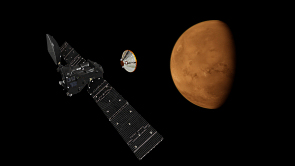Call for Media: ExoMars 2016 leaving Europe for launch site
16 November 2015
The ESA–Roscosmos ExoMars 2016 spacecraft are ready to depart Europe for the Baikonur Cosmodrome, Kazakhstan, to prepare for their launch in March.
 |
| Schiaparelli separating from the Trace Gas Orbiter. Credit: ESA/ATG medialab |
Members of the media are invited to join ExoMars scientists and engineers from ESA, Roscosmos and Thales Alenia Space in Cannes, France on 25 November for a final glimpse of the ExoMars Trace Gas Orbiter (TGO) and Schiaparelli, the entry, descent and landing demonstrator, before they leave.
The spacecraft will be launched on a Russian Proton rocket during the 14–25 March 2016 window, arriving at Mars in October 2016.
TGO will take a detailed inventory of Mars' atmospheric gases. Of special interest is the origin of methane – its presence implies an active, current source, and TGO will help to determine if it stems from a geological or biological source.
Schiaparelli will demonstrate a range of technologies to enable a controlled landing on Mars in preparation for future missions.
TGO will also serve as a data relay for the second ExoMars mission, comprising a rover and a surface science platform, which is planned for launch in 2018.
Programme
(all times in CET)
11:00–11:10
Welcome and the role of Thales Alenia in ExoMars
Donato Amoroso, Deputy CEO Thales Alenia Space
11:10–11:20
Robotic Exploration at ESA
Alvaro Gimenez, ESA Director of Science and Robotic Exploration
11:20–11:30
The role of Roscosmos in the ExoMars programme
Sergei Saveliev, Deputy Head Roscosmos
11:30–11:35
The role of Italy in the ExoMars programme
Barbara Negri, ASI responsible for the Observation of the Universe
11:30–11:50
ExoMars 2016 Mission Overview and Challenges
Giacinto Gianfiglio, ESA ExoMars deputy programme manager
11:50–12:00
ExoMars 2016 Industrial Challenges
Walter Cugno, Thales Alenia ExoMars Programme Director
12:00–12:20
Looking for Trace Gases and Signs of Past or Present Life on Mars, Science of the ExoMars programme
Jorge Vago, ESA ExoMars Project Scientist
12:20–12:35
The importance of the Exomars mission
Jean Pierre Bibring, University of Paris South
12:35–13:00
Opportunity for questions
13:00–14:00
Buffet lunch and interview opportunities
14:00 – 15:00
Visit of ExoMars in the clean room
15:00
End of programme
Media accreditation
Media interested in joining the event should email chrystelle.dugimont![]() thalesaleniaspace.com by Friday, 20 November 2015 at the latest, providing the following information: first name, surname, media, address, telephone and email as well as nationality, passport number, issue date and end date.
thalesaleniaspace.com by Friday, 20 November 2015 at the latest, providing the following information: first name, surname, media, address, telephone and email as well as nationality, passport number, issue date and end date.
A valid ID-Card or Passport is required to enter the event.
About ExoMars
ExoMars is a cooperation between ESA and the Russian space agency, Roscosmos, and comprises two missions. The first, for launch in 2016, is made up of the Trace Gas Orbiter, which will carry out investigations to try to determine the biological or geological origin of important trace gases on Mars, plus Schiaparelli, an entry, descent and landing demonstrator module. Schiaparelli will test key landing technologies for ESA's contributions to subsequent missions to Mars.
The second mission, planned for launch in 2018, comprises a European rover and a stationary Russian surface science platform. The rover will be the first mission to combine the capability of moving across the surface with the ability to drill two metres below the surface, in order to retrieve and analyse samples using the Pasteur payload of sophisticated instruments.
ExoMars is thus set to open a new era for Europe: moving from remote observation to surface exploration of Mars.
For further information:
ESA Media Relations Office
Email: media![]() esa.int
esa.int
Tel: +33 1 53 69 72 99
